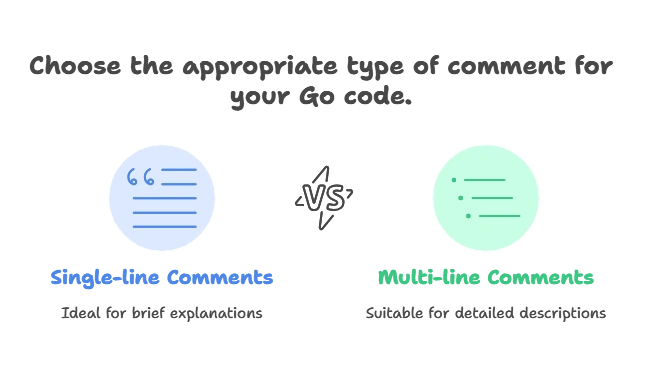Comments in Go
Welcome to the fascinating world of comments in the Go programming language! In this chapter, we'll dive deep into the basics, explore advanced techniques, and provide plenty of examples to help you grasp everything you need to know about commenting in Go, from start to finish.
Basic Understanding of Comments:
Comments are essential for making your code understandable to others and yourself. They are non-executable lines of text that are ignored by the compiler but provide crucial information about the code.
In Go, there are two types of comments: single-line comments and multi-line comments.

Single-Line Comments:
Single-line comments start with // and continue until the end of the line. They are ideal for brief explanations or annotations on a single line.
// This is a single-line comment
fmt.Println("Hello, world!") // This comment explains the following line
Multi-Line Comments:
- Multi-line comments, also known as block comments, begin with
/*and end with*/. They can span multiple lines and are often used for longer explanations, commenting out large sections of code, or temporarily disabling code.
/*
This is a multi-line comment.
It can span multiple lines.
*/
fmt.Println("Hello, world!")
Advanced Commenting Techniques:
Commenting Packages and Functions:
- Comments are not just for individual lines of code; they are also crucial for documenting packages and functions.
- Package comments provide an overview of the package’s purpose, functionality, and usage.
- Function comments explain what a function does, its parameters, return values, and any side effects.
// Package math provides basic mathematical functions.
package math
// Add returns the sum of two integers.
func Add(a, b int) int {
return a + b
}
Commenting Constants, Variables, and Types:
- Comments can accompany constants, variables, and types to clarify their purpose and usage.
- Clear and concise comments help other developers understand the intent behind these elements.
const pi = 3.14159 // pi is a mathematical constant representing the ratio of a circle's circumference to its diameter.
var count int // count keeps track of the number of items.
// User represents a user in the system.
type User struct {
ID int // ID is the unique identifier of the user.
Name string // Name is the user's name.
}
Comments are an indispensable part of writing clean, maintainable, and understandable code in Go. By using comments effectively, you can convey important information about your code's purpose, functionality, and usage to other developers. Whether it's a simple single-line comment or a detailed multi-line comment documenting a package or function, investing time in writing clear and informative comments will greatly benefit both you and your fellow developers in the long run. Happy coding !❤️
